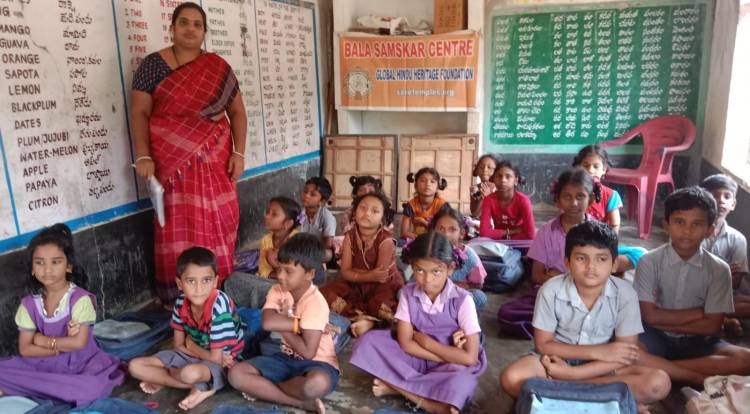[GHHF] Bala Samskar Kendra Students learned a sloka in Bhagavad Gita not to grieve about natural progression of human body from Childhood to old age.
 Global Hindu Heritage Foundation has been conducting Bala Samskar Kendras to educate our children about the richness of Sanatana Dharma, the variety of scriptures, the sacrifices of national heroes, dedication of European scientists to Scientifics treasure of Hindu Dharma and importance of cherishing ancient customs and traditions. The students learned the following sloka.
Global Hindu Heritage Foundation has been conducting Bala Samskar Kendras to educate our children about the richness of Sanatana Dharma, the variety of scriptures, the sacrifices of national heroes, dedication of European scientists to Scientifics treasure of Hindu Dharma and importance of cherishing ancient customs and traditions. The students learned the following sloka.
dehino’sminyathā dehe kaumāraṃ yauvanaṃ jarā
tathā dehāntaraprāptir dhīrastatra na muhyati (Bhagavad Gita: 2-13)
Just as in this body the embodied (soul) passes into childhood, youth and old age, so also does he pass into another body; the firm man does not grieve at it.
It is the law of memory that the experiencer and the memorizer must both be the same entity; then alone can memory power function. I cannot remember any of YOUR experiences nor can YOU remember any of MY experiences; I can remember my experiences as readily and easily as you can remember your experiences.
In old age, every one of us can remember the main incidents of his own childhood and youth. In the progress of growth, childhood dies away, and youth appears, and youth dies before old age can assert itself. In the old man, it is self-evident that neither his childhood nor his youth is with him, and yet, he can remember his own early days. Applying the principle of memory, it becomes quite clear then that ‘SOMETHING’ in us is common in all the different stages of our growth so that the same entity remembers the experiences gained by it in the past through the childish body, and later, through the youthful structure.
Thus, youthfulness may be considered as a birth, when childhood has met with its death. So too, old age is born when youth is dead. And yet, none of us is the least disturbed by these changes; on the other hand, we feel, in fact, happier due to the wealth of experiences we have
gained as the status of the body rose from innocent childhood to matured old age. Using this subjective experience of everyone in the world as a standard of comparison, Krishna is trying to bring home to Arjuna that wise men do not worry when they leave one body for the purpose of taking another one.
This stanza is again asserting, in unequivocal terms, the truth behind the Reincarnation Theory. And thus viewed, death can no more be a threat to a wise man. We do not moan at the death of childhood following which alone can we come to experience youth; we are confident
in our knowledge that though youth is entered into, and childhood has ended, there is a continuity of existence of the same one only, so, a child has now become a youth. So too, now of death, there is no extinction of the individuality, but the embodied ego of the dead body leaves its previous structure, and according to the Vasanas (mental impressions) that it had gathered during its embodiment, it gets identified with a physical equipment, where it can express itself completely, and seek its perfect fulfilment. (Source: Swami Chinmayananda)
Your donations are appreciated.
By Zelle: ghhfusaorg@gmail.com
PayPal: savetemples.org
By Check: Or you can send a check payable to GHHF, 14726 Harmony Lane, Frisco, TX 75035.
It is tax-deductible.
By Rupees: call 601-918-7111; +91 83096 43979






















 Urgent support needed for Bangladesh Hindus
Urgent support needed for Bangladesh Hindus 







